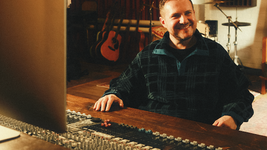GUSH by Hannah Perry Review - Somerset House
- Richelle Sushil
- Oct 3, 2018
- 3 min read
3 October - 4 November 2018
FREE
Nestled in the river rooms of Somerset house sits GUSH, a new exhibition by British contemporary artist Hannah Perry. In a stunning 360° immersive film central to the exhibition, Perry states the poignant purpose of her art as "a form of revenge in the terrain of mental health. As if by doing this, [she] could reverse it." Above all, the exhibition portrays the slippery nature of an emotion; a fluid, ever-in-motion, constantly changing thing, that is mirrored within the way the lens flits between one scene and the next, within the main installation. The curved screen upon which the video is projected, is quite an interesting choice; one which encloses the viewer in a semicircle, surrounding them, drawing them in, and making the installation almost impossible to glaze over. The audience is confronted by what is on the screen, and immediately engaged in the viewing of the pains and pleasures of what it means to be of, and exist within this hyperconnected 21st century society, the disadvantages of which are often swept under the rug.

The video itself is layered with a voiceover, evocative of what can be best described as fragments of poetic diary entries. These are intermingled with an originally composed score, and one which is very compelling in its subtle accompaniment of the subject matter - not so much distracting from it, as it contributes to the impact the piece has on an audience, providing an intensely emotional exploration of both, the good and bad, of what it means to exist within the present age. In perhaps one of the most memorable clips within the video, Perry skilfully modifies Kurt Vonnegut’s gorgeous line from Slaughterhouse Five, and depicts the way she sees that world as one within which "nothing is beautiful, and everything hurts." A line of profound and impactful sadness juxtaposed within the same video with shots that show a different side to life – one that is exhilarating, and full of ecstasy and vitality.
The exhibition is also concerned with ideas of how one sees oneself, under the influence of the media as well as the impacts this has on mental and emotional health. In a sculpture titled ‘Rage Fluids’, Perry uses her distinctive car modification trope by creating a vibrating sculpture made entirely of car body, which snakes around a large part of the room. Ever quivering, the closer you get to it, the harder it is to see yourself. The installation also makes a consistent whirring background noise, as the metal is pushed forward and backwards that is very easily ignored or overlooked. This can be said to mirror the pervading but unacknowledged impact that the media has on the mental states of consumers. The same can be said for one of the wall pieces that was part of the exhibition, within which the words ‘sex dreams in which I am perfect’ are embellished, in a subtle hue of light grey, perfectly capturing the deep but seldom actively acknowledged impact of physical and emotional insecurity within oneself, that is perpetuated by the media.

Central to the displayed pieces, is the idea of passion, and the rawness of emotion - both good and bad, which lend themselves to the experience of being human. This idea gives itself to the title of the exhibition – GUSH – which Perry portrays as a visceral release; an outpouring, of the insecurity, and the happiness, the inescapable pain that comes with living, as well as the irony of feeling isolated or alone in a society that is more connected than ever. Further, a prominent motif of the exhibition is that of fluidity, which is very much connected to the imagery portrayed by the title. It is a nod to the disconcerting and humbling truth that humans are simply flesh and blood, and that the ebbs and flows of all emotion exists solely within the parameters of the human body. The rawness and animality of our emotions, our passions, and our pain; all of it is contained within the gush of fluids within our bodies.
There is an unspoken sense of camaraderie in the room as I walk around viewing the different installations, in the sense that we are all grappling with our own issues, feeling our own gush of emotions, and witnessing this incredible representation of it, together. Seeing this exhibition is a deeply cathartic experience, and one which cannot be recommended enough.
































